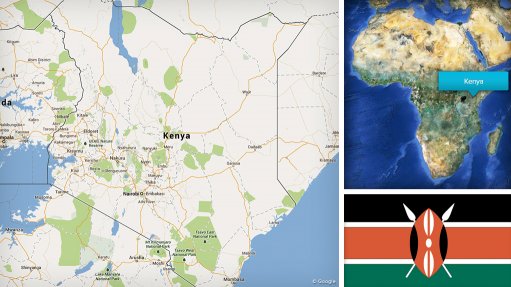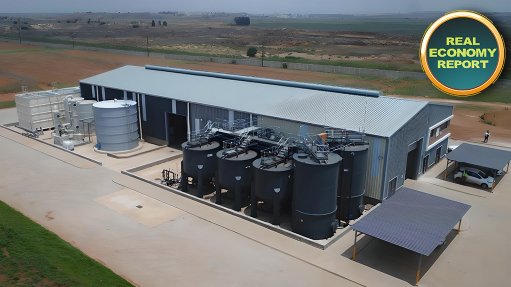Projects driven by regulatory improvements


FOCUSED ON THE FUTURE Sturdee Energy is excited to be in the financial close process of two 10 MW projects that will be starting construction shortly
Embedded electricity projects are increasing in size and complexity, owing to improvements in regulations. A wider variety of power solutions, capitalising on the benefits offered by independent power producers (IPPs), are available to address client requirements, says IPP Sturdee Energy executive director Andrew Johnson.
He explains that the increase of the licence-exempt threshold for embedded generation in South Africa has led to larger on-site projects being a more viable option benefitting from economies of scale. Larger embedded projects within the 5 MW to 50 MW range which exist together with the option of wheeling are now a feasible option for customers.
Wheeling refers to the delivery of energy from a generator to an end-user in another area using existing distribution or transmission networks.
As a result, there is increased interest from customers for power purchase agreements (PPAs) for larger on-site projects. They prefer to contract an IPP to provide an end-to-end solution that entails site selection, permitting, construction and supplying energy.
Johnson adds that companies are partnering with IPPs, such as Sturdee Energy, to procure a mix of energy from on-site generation, wheeling generation and electricity from State-owned power utility Eskom. IPPs offer energy solutions that are customised to the respective company’s risk appetite, demand profile, available land, sustainability and energy strategies.
IPPs that offer a range of energy solutions as part of an energy mix can provide blended tariffs or an overall solution that results in the highest energy savings.
“Essentially, IPPs take on the project risk while the client benefits from having the asset on its property connected into its infrastructure, and can save on certain use-of-system and grid-wheeling charges,” he elaborates.
Further, developments in the environmental and regulatory approvals space are helping to fuel demand for embedded solutions and supporting the development of embedded solutions.
Johnson says lenders are becoming more comfortable with the default risks associated with embedded projects, owing to improvements and more certainty from Eskom’s grid access units.
These units are also starting to require more detailed technical information and oversight when assessing budget quotes for embedded projects. This is expected to improve the technical design and quality of such projects.
Sturdee has relied extensively on its renewable IPP programme project experience to secure the environmental and grid connection approvals on its smaller embedded projects, says Johnson.
Growing Knowledge
There are also increased efficiencies and growing clarity around regulatory authority the National Energy Regulator of South Africa’s registration process for embedded projects, which now allows for projects to be converted to wheeling projects if required.
Offtakers are more knowledgeable regarding PPAs and the contracting structure, with companies consequently being more open to long-term agreements than previously.
Clients are also conducting a more detailed analysis of the cost savings, such as tariffs and use-of-system charges, as well as the risks associated with embedded and wheeling projects.
The carbon credit revenue model is still unclear together with the registration process, associated costs and regulations.
Additiionally, Johnson notes that there are other challenges impacting on IPPs.
Navigating Risks
IPPs face risks associated with macroeconomic factors such as exchange rates, interest rates and procurement timelines for essential equipment.
To navigate these risks, IPPs and their clients must work together to develop transparent approaches, he says.
This includes assessing the financial impact of these factors on projects and implementing strategies such as early procurement and hedging, and disclosing upfront the base case variables in contracts.
Johnson also highlights that lengthy timelines have a significant impact on pricing and overall project costs, as implementing IPP projects – from prefeasibility to obtaining the necessary authorisations and approval for land use – is a time-consuming process.
Consequently, collaboration among IPPs and clients is crucial to ensure a shared understanding of the complex developmental processes, especially regarding project financing and construction.
“Things change from the time of starting development to the time you are ready to start construction. All the parties need to be informed of the assumptions on day one so they can be tracked through the project process,” Johnson explains.
He notes that the time and costs associated with the development of a project, as well as the legal and technical work streams, are the same – whether it be a 5 MW or a 30 MW project.
Further, he says that the former Embedded Generation Task Team was instrumental in assisting Sturdee Energy in progressing and unblocking permitting processes that had delayed the development of its embedded projects.
The function of the task team has now been transferred to the Energy One Stop Shop at the Department of Trade, Industry and Competition’s Pretoria Campus, which is expected to continue providing assistance to IPPs.
However, there is also uncertainty surrounding grid code compliance. Eskom and the grid code compliance frameworks pose challenges for IPPs, particularly regarding the point-of-connection, whereby grid-code compliance should be measured for larger generators.
Johnson explains that industrial clients running plants and mines while pursuing behind-the-meter projects face complexities when aligning Eskom’s point of connection and grid code compliance requirements with those of a solar plant.
There is also a lack of suitable, experienced and financially sound contractors. This is owing to many of the leading engineering, procurement and construction companies focusing on the much larger scale projects.
Current planned and ongoing projects are often too small for the larger players, but are technically and financially challenging for smaller contactors that are trying to move up the value chain from rooftop installations.
“Many contactors say they are able to do solar and embedded projects. However, the challenge is [that] very few are able to do it well and to the same standard that larger projects are delivered,” he says.
However, for its part, Sturdee Energy is excited to be in the financial close process of two 10 MW projects that will be starting construction shortly, Johnson concludes.
Comments
Press Office
Announcements
What's On
Subscribe to improve your user experience...
Option 1 (equivalent of R125 a month):
Receive a weekly copy of Creamer Media's Engineering News & Mining Weekly magazine
(print copy for those in South Africa and e-magazine for those outside of South Africa)
Receive daily email newsletters
Access to full search results
Access archive of magazine back copies
Access to Projects in Progress
Access to ONE Research Report of your choice in PDF format
Option 2 (equivalent of R375 a month):
All benefits from Option 1
PLUS
Access to Creamer Media's Research Channel Africa for ALL Research Reports, in PDF format, on various industrial and mining sectors
including Electricity; Water; Energy Transition; Hydrogen; Roads, Rail and Ports; Coal; Gold; Platinum; Battery Metals; etc.
Already a subscriber?
Forgotten your password?
Receive weekly copy of Creamer Media's Engineering News & Mining Weekly magazine (print copy for those in South Africa and e-magazine for those outside of South Africa)
➕
Recieve daily email newsletters
➕
Access to full search results
➕
Access archive of magazine back copies
➕
Access to Projects in Progress
➕
Access to ONE Research Report of your choice in PDF format
RESEARCH CHANNEL AFRICA
R4500 (equivalent of R375 a month)
SUBSCRIBEAll benefits from Option 1
➕
Access to Creamer Media's Research Channel Africa for ALL Research Reports on various industrial and mining sectors, in PDF format, including on:
Electricity
➕
Water
➕
Energy Transition
➕
Hydrogen
➕
Roads, Rail and Ports
➕
Coal
➕
Gold
➕
Platinum
➕
Battery Metals
➕
etc.
Receive all benefits from Option 1 or Option 2 delivered to numerous people at your company
➕
Multiple User names and Passwords for simultaneous log-ins
➕
Intranet integration access to all in your organisation



















